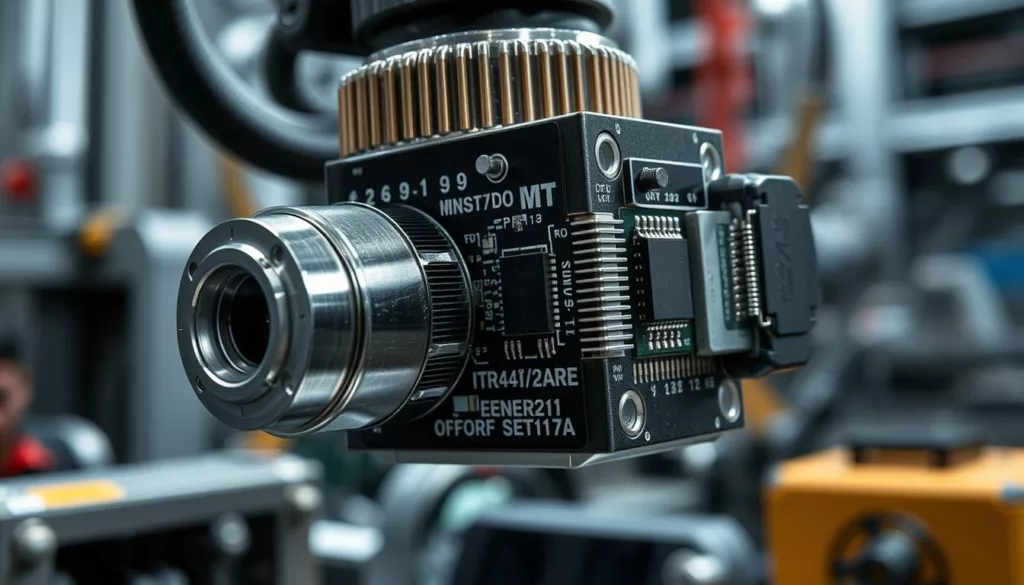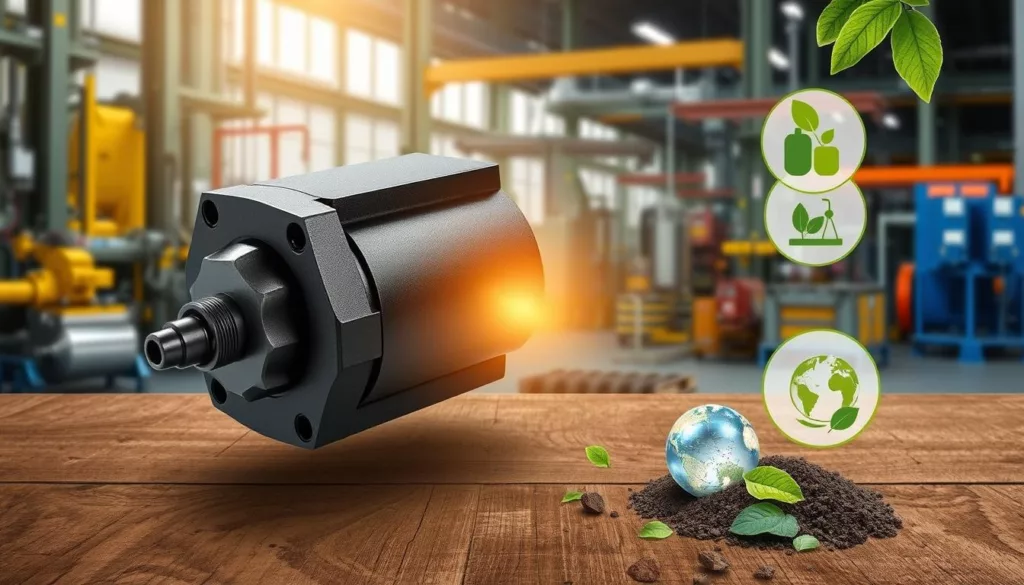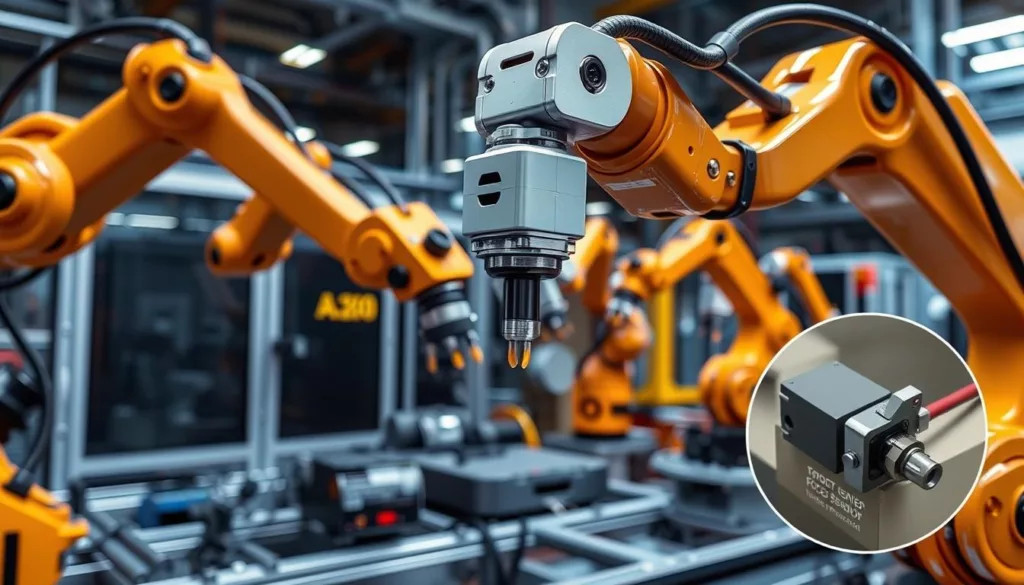In the world of industry, precision and reliability are key. This guide helps professionals, engineers, and buyers pick the best 3 axis force sensor. We know how important accurate force measurement is for better work efficiency.
We use our knowledge and creativity to help you make the right choice. This guide will give you the insights you need to pick the right Industrial 3 Axis Force Sensor.
Key Takeaways
- Understand the function and types of industrial force sensors.
- Identify key considerations such as load capacity and environmental conditions.
- Ensure compatibility with existing systems to streamline implementation.
- Evaluate specifications focusing on measurement range and accuracy.
- Recognize the diverse applications of force sensors in modern manufacturing.
- Prepare for common challenges in measurement and environmental factors.
- Implement best practices for installation and long-term maintenance.
Understanding 3 Axis Force Sensors
A 3 axis force sensor measures forces in three planes. This is key in industries needing precise force data. We’ll explore what these sensors are and the types available for different uses.
What is a 3 Axis Force Sensor?
A 3 axis force sensor tracks force on the X, Y, and Z axes. They’re used in robotics, material testing, and manufacturing. Their accuracy makes them essential for detailed force measurements.
Types of 3 Axis Force Sensors Available
Knowing the types of force sensors helps pick the right one for your needs. Here are some common ones:
- Strain Gauge Sensors: Known for their reliability and accuracy, used in many places.
- Piezoelectric Sensors: Great for measuring dynamic forces, perfect for high-speed environments.
- Capacitive Sensors: Best for static force, used where there’s little mechanical movement.

Key Factors in Selecting Industrial Force Sensors
Choosing the right industrial force sensor is key. It’s important to consider the load capacity and how the environment might affect it. This ensures the sensor works well and accurately.
Load Capacity Considerations
The sensor’s load capacity must match the job it will do. Knowing the maximum weight it will handle is critical. This way, it can deal with peak loads without losing performance.
It’s smart to pick a sensor that can handle more than you expect. This helps with unexpected changes in load.
Environmental Conditions Impact on Performance
Environmental factors greatly affect how well a force sensor works. Things like temperature, humidity, and chemicals can hurt its accuracy and lifespan. It’s vital to pick sensors that can stand up to these challenges.
This ensures they perform well, even in tough industrial environments. For more on different sensor types, check out this resource.
| Load Capacity | Typical Applications | Environmental Resilience |
|---|---|---|
| 1000 N | Aerospace Testing | Temperature -20°C to 50°C |
| 5000 N | Industrial Automation | Humidity 0% to 95% |
| 10000 N | Robotics | Chemical Resistance: Mild Acids |
Choosing the Right 3 Axis Force Sensor for Industrial Use
Choosing the right 3 axis force sensor for industrial use is key. It’s important to check if it fits with your current systems and meets specific circuit needs. Knowing these details helps make the right choice.
Compatibility with Existing Systems
For the best results, make sure the sensor works well with your machines and data systems. A sensor that fits right away saves time and money. Checking if the sensor matches your current setup is a big part of making a good choice.
Circuitry and Interface Requirements
Think about the sensor’s circuitry and interface needs too. The sensor must send the right signals to your system. This could be analog or digital signals. Knowing what your system needs helps avoid problems.
| Factor | Description |
|---|---|
| Compatibility | Sensor should integrate seamlessly with existing machinery. |
| Circuit Requirements | Output signals must match the specifications of the industrial system. |
Force Sensor Specifications to Consider
When picking a force sensor, knowing the important specs is key. Look at the measurement range and resolution. Also, check if it meets calibration standards.
Measurement Range and Resolution
The measurement range shows what forces the sensor can measure. It’s important for knowing if the sensor fits your needs. The resolution tells you the smallest force change the sensor can spot. These two together show how well the sensor can handle small force changes.
Calibration and Accuracy Standards
Calibration is essential for keeping measurements right. Use ISO and ANSI standards for this. Following these standards means your sensor gives consistent, reliable data. This is vital for controlling processes in industries.
Industrial Applications of Force Sensors
Force sensors are key in many fields, like manufacturing and robotics. They help make things better and safer. Let’s see how they work in real-world settings.
Usage in Manufacturing Processes
In factories, force sensors watch over assembly and check quality. They offer:
- Real-time data to track how well things are made.
- Alerts for any issues, so problems can be fixed fast.
- Better checks on how much weight things can hold.
They help make sure products are made right every time.
Force Measurement in Robotics
In robotics, 3 axis force sensors are very important. They help robots:
- Feel their way through tasks safely.
- Adjust to changing situations smoothly.
- Do tricky jobs with great precision.
| Application Area | Key Benefits | Examples |
|---|---|---|
| Manufacturing Processes | Improved production quality and efficiency | Automated assembly, quality checks |
| Robotics | Enhanced safety and interaction accuracy | Collaborative robots, precision tasks |
Benefits of Using Industrial Force Sensors
Using industrial force sensors in manufacturing has many advantages. Knowing these benefits helps make smart choices about using sensors. This section talks about two key benefits: precision and cost savings.
Improved Precision and Efficiency
Force sensors are key for better accuracy in work. They help make products better and more consistent. This means less mistakes and more efficient work.
Being able to adjust quickly during production makes things run smoother. It helps make production lines more efficient. This is important for keeping work flowing well.
Cost Savings Over Time
At first, buying high-quality force sensors might seem expensive. But, the long-term gains are much bigger. These sensors help cut down on waste and lower costs.
They also make work more productive. This means companies can save money over time. Using force sensors is a smart move for many industries.
Common Challenges in 3 Axis Sensor Selection
Choosing 3 axis force sensors can be tricky. It’s important to tackle measurement errors and manage environmental factors well. This ensures the sensors work as they should. With the right approach, we can make sensor readings more accurate and dependable.
Overcoming Measurement Errors
Measurement errors can really mess up sensor data. These errors often come from misalignment and environmental noise. To fix this, we need to:
- Regularly calibrate sensors to keep them precise.
- Make sure sensors are properly aligned during setup.
- Use methods to cut down on environmental noise.
By tackling these issues, we can beat many challenges in sensor selection linked to measurement errors. For more tips, check out this guide on integrating sensors in automated systems.
Dealing with Environmental Factors
Environmental factors like temperature, moisture, and vibrations can harm 3 axis force sensors. It’s vital to pick sensors made for your environment. Think about:
- What temperature range the sensors can handle.
- Whether you need moisture-resistant or waterproof models.
- The level of vibrations or shocks in your area.
Making a smart choice helps sensors work better and last longer. This saves money and boosts work efficiency.
Tips for Effective Force Sensor Implementation
Putting force sensors in industrial settings needs careful planning. Knowing how to install and maintain them is key.
Installation Best Practices
Installing force sensors right means following the maker’s rules. Important steps include:
- Make sure sensors are in the right spot for better accuracy.
- Use strong mounts to keep sensors steady while they work.
- Calibrate sensors well to meet your application’s needs.
Following these steps helps sensors work better and cuts down on data errors.
Maintenance Guidelines for Longevity
Keeping sensors in good shape is vital for their life. Good maintenance includes:
- Check sensors often for damage or wear.
- Recalibrate sensors regularly to keep measurements accurate.
- Watch out for things in the environment that might harm sensor performance.
Having a solid maintenance plan keeps sensors running smoothly and makes them last longer. For more on using load cells and force sensors well, check out this link.
| Practice | Description |
|---|---|
| Installation Positioning | Correctly place sensors to enhance data accuracy and reduce errors. |
| Secure Mounts | Use reliable mounts to ensure sensors remain stable during operations. |
| Regular Inspections | Check sensors routinely for physical damage or wear to extend service life. |
| Calibration | Recalibrate sensors periodically for optimal performance and accuracy. |
Conclusion
Choosing the right 3 axis force sensor is key to boosting efficiency and precision in many industries. Knowing the different types, their specs, and practical considerations helps us make smart choices. This way, we meet our specific needs.
This guide has given us vital info on load capacities, environmental effects, and system compatibility. We see how custom solutions can greatly improve performance. This boosts productivity in our work.
At XJCSENSOR, we focus on creating tailored sensor solutions with our deep technical know-how. We aim to provide top-notch products and the needed knowledge for their use. Let’s embrace new sensor tech and improve our industrial work now.




